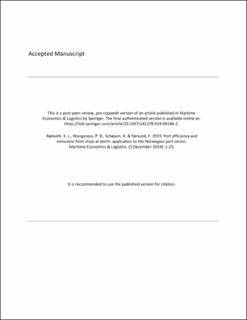Port efficiency and emissions from ships at berth: application to the Norwegian port sector
Original version
Rødseth, K. L., Wangsness, P. B., Schøyen, H., & Førsund, F. R. (2019). Port efficiency and emissions from ships at berth: application to the Norwegian port sector. Maritime Economics & Logistics, 1-25. https://doi.org/10.1057/s41278-019-00146-2Abstract
This paper explores how port efficiency affects the time that ships spend in port and therefore their atmospheric emissions whilst berthed. While the literature on port productivity and efficiency measurement largely ignores this aspect, we explore the biases in the measurement of productivity when resources spent on providing swift cargo-handling are ignored. A distinction is made between ports’ technical and scale efficiencies. Their impacts on environmental productivity (i.e., units of cargo handled per unit of ship emissions) are examined using data envelopment analysis on a unique dataset containing information about the duration of cargo-handling operations in the 25 largest ports in Norway. The results show that adopting best practices can significantly improve environmental productivities: if all ports under consideration become technically productive, the environmental productivity of the entire sample could be 80% higher. Technical efficiency alone would increase average environmental port productivity by 30%. Enhancing traditional port productivity can also substantially improve environmental productivity.
